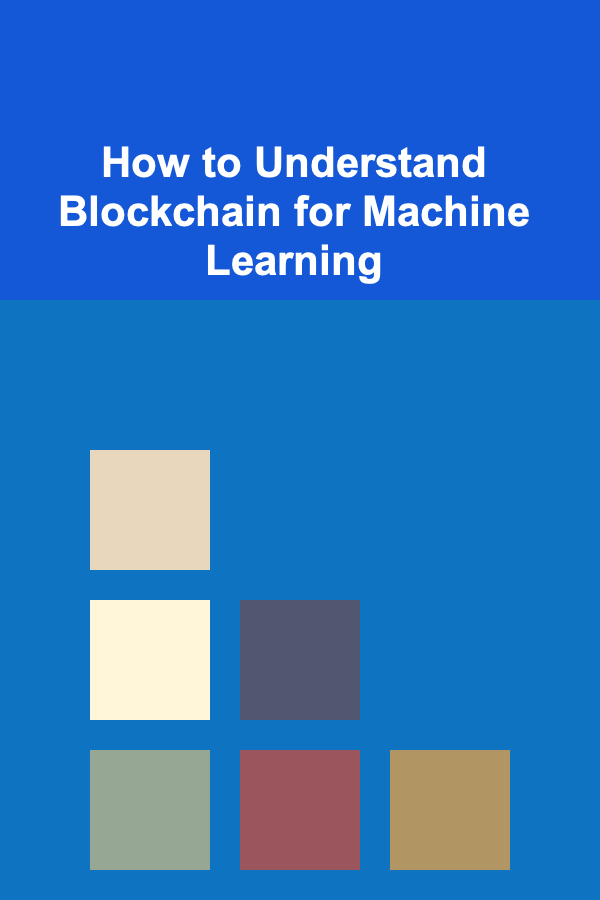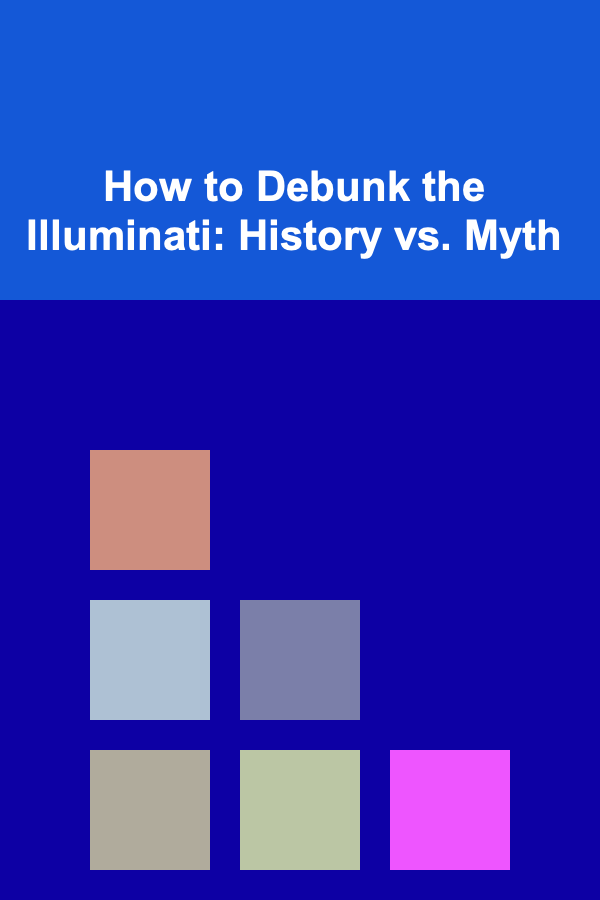
How to Understand Blockchain for Machine Learning
ebook include PDF & Audio bundle (Micro Guide)
$12.99$7.99
Limited Time Offer! Order within the next:

Blockchain and machine learning (ML) are two cutting-edge technologies that have gained widespread attention in recent years. Though they are often discussed separately, the integration of these technologies presents an exciting potential for the future. Understanding how blockchain can be leveraged for machine learning is crucial for developers, data scientists, and industry experts who want to harness the power of both. This article will explore how blockchain and machine learning intersect, their mutual benefits, and the challenges involved in combining the two technologies.
Blockchain Fundamentals
Before diving into how blockchain can enhance machine learning, it's important to understand the basics of blockchain technology. A blockchain is a distributed, decentralized ledger that records transactions across multiple computers in a way that ensures security, transparency, and immutability. Blockchains are most commonly associated with cryptocurrencies like Bitcoin and Ethereum, but their use cases extend far beyond digital currencies.
Key Characteristics of Blockchain
- Decentralization: Unlike traditional centralized systems where a single entity controls the database, blockchain operates in a decentralized manner. This means there is no central authority overseeing the system, and transactions are verified by multiple participants (nodes) in the network.
- Immutability: Once a transaction is recorded on the blockchain, it cannot be altered or deleted. This feature provides an immutable audit trail, making blockchain an ideal solution for applications requiring data integrity and transparency.
- Transparency: Blockchain ensures transparency by providing open access to transaction data. Each participant in the network can view and verify the transactions stored on the blockchain.
- Security: Blockchain uses cryptographic techniques to secure data, making it resistant to fraud, hacking, and unauthorized alterations.
- Consensus Mechanisms: Blockchain networks rely on consensus algorithms to agree on the validity of transactions. Examples include Proof of Work (PoW) and Proof of Stake (PoS).
Blockchain Applications
Blockchain technology has found applications in various sectors, including finance, healthcare, supply chain management, and more. Its ability to provide secure, transparent, and immutable records has made it a valuable tool for data-driven industries.
Machine Learning Fundamentals
Machine learning, a subset of artificial intelligence (AI), involves algorithms and statistical models that allow computers to improve their performance on tasks through experience without being explicitly programmed. ML is already transforming industries by enabling systems to make predictions, detect patterns, and automate complex processes.
Types of Machine Learning
- Supervised Learning: In supervised learning, a model is trained on labeled data, meaning the input data is paired with the correct output. The model learns to map inputs to outputs and is evaluated based on its ability to predict new, unseen data.
- Unsupervised Learning: Unsupervised learning involves training a model on unlabeled data. The model must identify patterns or structure in the data, such as clustering similar data points together or reducing the dimensionality of the data.
- Reinforcement Learning: Reinforcement learning is based on trial and error. An agent learns to make decisions by interacting with an environment and receiving feedback in the form of rewards or penalties.
- Semi-supervised and Self-supervised Learning: These approaches fall in between supervised and unsupervised learning. Semi-supervised learning uses a small amount of labeled data and a large amount of unlabeled data, while self-supervised learning involves training a model to predict part of the data from other parts of the same data.
Machine Learning Applications
Machine learning has a broad range of applications, including natural language processing, image recognition, recommendation systems, autonomous vehicles, and medical diagnostics. It is revolutionizing industries by providing data-driven solutions and enabling systems to adapt and improve over time.
The Intersection of Blockchain and Machine Learning
While blockchain and machine learning have their individual strengths, the integration of the two technologies opens up new opportunities. Here's how blockchain can benefit machine learning:
1. Ensuring Data Integrity
One of the key challenges in machine learning is ensuring the quality and integrity of the data used for training models. In traditional systems, data can be tampered with, which can lead to biased or incorrect models. Blockchain can address this issue by providing a decentralized, immutable ledger that records the provenance of data. Each transaction involving data, whether it's a data acquisition, transformation, or model training, can be recorded on the blockchain, ensuring transparency and accountability.
For example, in the healthcare industry, patient data used for training machine learning models can be recorded on a blockchain. This ensures that the data has not been altered, preventing issues such as data poisoning (where inaccurate data is introduced to manipulate the model's behavior) and ensuring that the models trained on this data are trustworthy.
2. Federated Learning and Blockchain
Federated learning is a decentralized approach to machine learning that allows multiple devices (such as smartphones, IoT devices, or edge devices) to collaboratively train a model without sharing raw data. Each device trains a local model on its data and sends only the model updates (gradients) to a central server. The central server aggregates these updates to improve the global model.
Blockchain can enhance federated learning by providing a secure and transparent way to handle the aggregation of model updates. By using blockchain, it is possible to verify the authenticity of the updates, ensuring that no participant in the network is tampering with the model training process. Additionally, blockchain can provide an incentive mechanism for participants to contribute their computing resources to federated learning.
3. Decentralized AI Marketplaces
Blockchain can also facilitate the creation of decentralized marketplaces for machine learning models and data. In such marketplaces, data owners and machine learning model creators can trade data and models securely without the need for a central authority. Smart contracts, a feature of blockchain platforms like Ethereum, can be used to enforce the terms of these transactions, ensuring that both parties fulfill their obligations.
For example, data owners can upload their data to a blockchain-based marketplace, where machine learning researchers can purchase it for model training. Blockchain ensures that the transaction is transparent and that the data is used only for the agreed-upon purpose. Additionally, the use of blockchain can protect intellectual property by securely recording ownership and usage rights.
4. Trust and Transparency in Machine Learning Models
Machine learning models, especially deep learning models, are often referred to as "black boxes" because it can be difficult to understand how they arrive at their predictions. This lack of transparency is a significant barrier in industries where explainability is critical, such as healthcare, finance, and law.
Blockchain can improve the trust and transparency of machine learning models by providing an immutable and auditable record of the model's decision-making process. Each step in the training and deployment of a machine learning model can be recorded on the blockchain, including the data used, the algorithm parameters, and the model's predictions. This provides a transparent trail that can be audited by stakeholders, helping to explain how a model arrived at a particular decision and increasing trust in AI systems.
5. Data Provenance and Ownership
In machine learning, data is a critical asset. However, the ownership and provenance of data are often unclear, especially when it comes from multiple sources. Blockchain can solve this problem by providing a transparent and immutable record of data ownership. Each piece of data, whether it is collected from an individual, organization, or IoT device, can be tracked on the blockchain, ensuring that the data's provenance is clear and that the owner's rights are respected.
For example, in the context of personal data, blockchain can allow individuals to retain control over their data while still participating in machine learning processes. By recording the data ownership and usage rights on the blockchain, individuals can be compensated for the use of their data or can choose to share it only with specific entities.
6. Privacy-Preserving Machine Learning
Privacy is a significant concern when it comes to machine learning, especially when working with sensitive data such as healthcare records, financial information, or personal communications. Blockchain can contribute to privacy-preserving machine learning techniques, such as homomorphic encryption and differential privacy.
Homomorphic encryption allows computations to be performed on encrypted data, meaning that the data never needs to be decrypted. Blockchain can facilitate this by securely storing encrypted data and allowing machine learning models to operate on it without exposing the underlying data. This ensures that the privacy of individuals is maintained while still enabling the benefits of machine learning.
Differential privacy is another technique that can be used to preserve privacy when training machine learning models. By adding noise to the data or model outputs, differential privacy ensures that no individual's information can be uniquely identified. Blockchain can support this approach by recording privacy-preserving operations on the blockchain and ensuring that the data remains anonymized.
Challenges of Integrating Blockchain with Machine Learning
While the combination of blockchain and machine learning offers many benefits, there are several challenges to overcome:
- Scalability: Blockchain networks, especially those that use proof-of-work (PoW) consensus algorithms like Bitcoin, can be slow and expensive. Scaling blockchain to handle the vast amounts of data generated by machine learning models could require significant advancements in blockchain technology.
- Complexity: Integrating blockchain with machine learning adds complexity to both systems. Developers must ensure that blockchain's decentralized nature does not interfere with the performance of machine learning models and that the integration is secure.
- Data Privacy: While blockchain can enhance data privacy, it also raises concerns. The public nature of some blockchain networks means that sensitive data could be exposed to the public. Privacy-preserving techniques like homomorphic encryption and differential privacy can mitigate this, but they come with their own challenges.
- Adoption: The integration of blockchain and machine learning is still in its early stages, and widespread adoption will require overcoming regulatory, technical, and economic barriers. Industry stakeholders must work together to develop standardized practices and frameworks for this integration.
Conclusion
Blockchain and machine learning are two transformative technologies that can complement each other in a variety of ways. Blockchain can enhance machine learning by ensuring data integrity, enabling federated learning, fostering decentralized AI marketplaces, and improving trust and transparency. However, the integration of blockchain with machine learning also presents challenges, including scalability, complexity, and privacy concerns.
As both technologies continue to evolve, the potential for their synergy will only grow. By leveraging blockchain's decentralized, transparent, and immutable features, machine learning can become more secure, trustworthy, and efficient. This intersection holds great promise for a wide range of industries, from healthcare to finance to AI research, and will likely play a key role in shaping the future of technology.

How to Use Seasonal Baskets for Easy Holiday Storage
Read More
The Art of Photography: Capturing Moments in Time
Read More
The Clinical Research Coordinator's Playbook: Streamlining Processes in Medical Research
Read More
How to Debunk the Illuminati: History vs. Myth
Read More
Interpreting Ancient Maps and Geography: A Deep Dive
Read More
10 Strategies for Effective To-Do List Management in Sudoku
Read MoreOther Products

How to Use Seasonal Baskets for Easy Holiday Storage
Read More
The Art of Photography: Capturing Moments in Time
Read More
The Clinical Research Coordinator's Playbook: Streamlining Processes in Medical Research
Read More
How to Debunk the Illuminati: History vs. Myth
Read More
Interpreting Ancient Maps and Geography: A Deep Dive
Read More